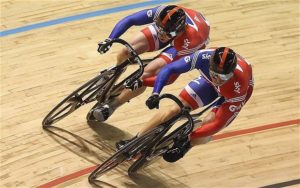Why all cyclists need to ‘hit the Gym’ – part 2
In “Cycling and bone health” we learnt that road cycling is not good for your bones with research showing that bone mineral density (BMD) is compromised over the long-term. This is not good news for those that want to get their training, exercise or racing fix solely from road cycling. One of the questions that I often get asked is, are there any differences between professional road cyclists and the rest of us and do any differences exist between all other cycling disciplines (track vs. road for example) in relation to skeletal health?
Interestingly, elite professional road cyclists have been shown to suffer the same detrimental changes to certain bones of the skeletal system (6). In 1996 the European Spine Journal published a study by Sabo and colleagues (1) that measured BMD of the lumbar spine in internationally top-ranked high-performance athletes of different disciplines – weight lifters, boxers, and endurance-cyclists. The measurements were carried out by dual-energy X-ray absorptiometry, and the results compared with the measurements of 21 age-matched male controls. The BMD of the high-performance weight lifters and boxers were significantly greater (range +17% to +24%) than that in the control group. In stark contrast, the BMD of the lumbar spine in all endurance cyclists was significantly lower than that in the controls (range -8% to -10%).
In a study conducted by Lombardi and co-workers (2012) the effects of bone and energy metabolism parameters in professional cyclists during the 2011 Giro d’Italia 3-week stage race were investigated. In this cycling race, bone metabolism was pushed towards resorption. This is the process by which osteoclasts break down bone and release the minerals, resulting in a transfer of calcium from bone fluid to the blood. What is fascinating about these findings is that it supports the evidence of a strict involvement of bone in the regulation of the energy metabolism (2).
Unlike the reduction in BMD seen in road cyclists, mountain bikers or track cyclists are not afflicted with the same issues. To the contrary, both these cycling disciplines demonstrate no evidence of any detrimental osteogenic changes to skeletal health. Mountain bikers were found in a 2002 paper published in Bone journal to have significantly higher BMD than road cyclists (3). McVeigh and colleagues in 2014 had their findings published in the European Journal of Sports Science. What they found was that Mountain biking – owing to the rougher terrain involved – probably imposes a greater osteogenic stimulus compared to road cycling due to the higher amounts of bone strain largely attributable to greater ground surface-induced loads. The greater resorptive activity seen in road cycling suggests inadequate loading to support bone maintenance with bone loading, muscle size and strength of Mountain biking being superior to Road cycling (4).

Wilks and others (2009) compared bone measures of sprint- and distance-trained cyclists competing at World Masters Track Championships, along with sedentary controls in their study published in the journal, Medicine and Science in Sports and Exercise. Greater lower leg bone strength was found in the sprinters and to a lesser degree the endurance riders compared with sedentary controls (5).
In conclusion, then, based on a review of the evidence that is available there is now a pressing need for road cyclists at any level or age to supplement their training with some weight-bearing exercise so that bone health is maintained. However, whilst there are many different weight-bearing exercise options available to fulfil these needs I think that the scientific evidence is strongest for the inclusion of adjunctive gym-based, weight training as it seems to provide the most effective stimulus to improve skeletal health. Moreover, there is good evidence to suggest that endurance cycling performance can be improved with the inclusion of this type of exercise too. I will discuss the interesting research supporting this, in particular for the older cyclist, in a future article.
Click “Cycling and bone health” (part 1) to read the first installment of this 2-part discussion of bone health in cyclists.
References
1. Sabo D, et al. Bone quality in the lumbar spine in high-performance athletes. European Spine Journal, 1996; 5 (4): 258–263.
2. Lombardi G, Lanteri P, Graziani R, Colombini A, Banfi G, et al. (2012) Bone and Energy Metabolism Parameters in Professional Cyclists during the Giro d’Italia 3-Weeks Stage Race. PLoS ONE 7(7): e42077.
3. Warner SE, et al. Bone mineral density of competitive male mountain and road cyclists. Bone, Jan 2002; 30 (1): 281-286.
4. Joanne A. Mcveigh, Rebecca Meiring, Alessandra Cimato, Lisa K. Micklesfield & Tanja Oosthuyse (2014): Radial bone size and strength indices in male road cyclists, mountain bikers and controls, European Journal of Sport Science, DOI: 10.1080/17461391.2014.933881.
5. Wilks DC, et al. Forearm and tibial bone measures of distance- and sprint-trained master cyclists. Medicine and Science in Sports and Exercise, Mar 2009; 41 (3): 566-573.
6. https://www.thieme-connect.com/DOI/DOI?10.1055/s-0029-1243616
For local Townsville residents interested in FitGreyStrong’s Exercise Physiology services or exercise programs designed to improve muscular strength, physical function (how you move around during the day) and quality of life or programs to enhance cycling or athletic performance, contact FitGreyStrong@outlook.com or phone 0499 846 955 for a confidential discussion.
For other Australian residents or oversees readers interested in our services, please see here.
Disclaimer: All contents of the FitGreyStrong or FGS website/blog are provided for information and education purposes only. Those interested in making changes to their exercise, lifestyle, dietary, supplement or medication regimens should consult a relevantly qualified and competent health care professional. Those who decide to apply or implement any of the information, advice, and/or recommendations on this website do so knowingly and at their own risk. The owner and any contributors to this site accept no responsibility or liability whatsoever for any harm caused, real or imagined, from the use or distribution of information found at FGS. Please leave this site immediately if you, the reader, find any of these conditions not acceptable.
© FitGreyStrong






